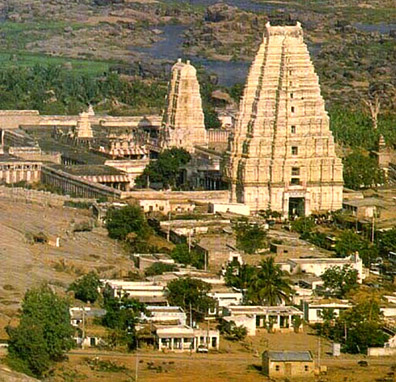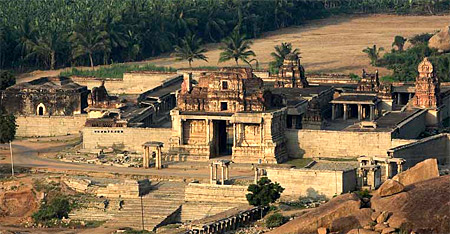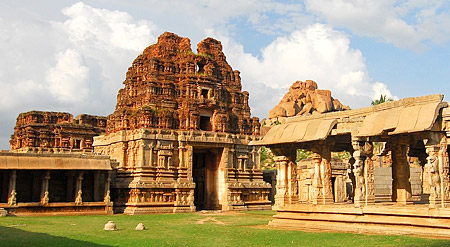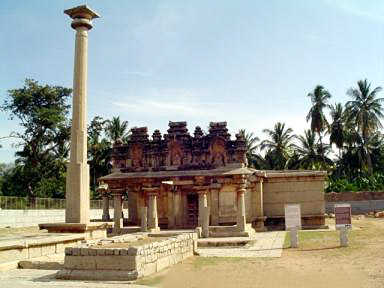Vijayanagara consciously promoted religious activity, particularly, in the heyday of the kingdom, when a variety of religious cults were incorporated into the capital city and a large number of religious establishments were constructed. The temples at the site range from tiny, inconspicuous structures to large, grandiose monuments. While some of the temples and shrines were of great importance from the religious and historical points of view, others were of little significance.
With the formalization of the Pampa-Virupaksha cult in the twelfth century, the construction of a temple to this deity was formed. Hampi was already a Shaivite tirtha by this time, as is indicated by the presence of a number of pre-Vijayanagara Shaiva temples on Hemakuta hill and all the way from the hill to the river. The earliest of these, the present-day Durga devi temple, is in the Rashtrakuta style of the ninth-tenth centuries. These pre-Vijayanagara temples are small, comprising only a cella; or a cella and an antechamber; or a sanctum, antechamber and a mandapa. The primitive Virupaksha shrine must have been one such small temple, but no architectural details are available about it since it has been completely enveloped or replaced by constructional additions or extensions of the Vijayanagara period.
 The existence of the Virupaksha temple in the twelfth century is also proved by the inscription of 1199 AD, inscribed on a finely polished schist slab, now the Durga devi temple. It refers to a grant of land made to seven hundred Brahmins of Hampi and for the worship of the deities of the place such as Virupaksha, Hampa-devi, Bhairava and Lord Rama. The Virupaksha Temple rises majestically at the western end of the Hampi Bazaar. This shrine continued to be of significance in the thirteenth century and it gives the genealogy of the Hoysala empire and records the gift made by king Somesvara (1233-1267) of the revenue of a village for conducting the worship of Virupaksha at Parhpa-kshetra and feeding the Brahmins in the "chattra" attached to the temple. The existence of the "chattra" and the Brahmins connected with the temple, points to the fact that the Virupaksha temple was already a centre not only of religious activities, but also of charitable and scholarly pursuits.
The existence of the Virupaksha temple in the twelfth century is also proved by the inscription of 1199 AD, inscribed on a finely polished schist slab, now the Durga devi temple. It refers to a grant of land made to seven hundred Brahmins of Hampi and for the worship of the deities of the place such as Virupaksha, Hampa-devi, Bhairava and Lord Rama. The Virupaksha Temple rises majestically at the western end of the Hampi Bazaar. This shrine continued to be of significance in the thirteenth century and it gives the genealogy of the Hoysala empire and records the gift made by king Somesvara (1233-1267) of the revenue of a village for conducting the worship of Virupaksha at Parhpa-kshetra and feeding the Brahmins in the "chattra" attached to the temple. The existence of the "chattra" and the Brahmins connected with the temple, points to the fact that the Virupaksha temple was already a centre not only of religious activities, but also of charitable and scholarly pursuits.
The outstanding importance of Virupaksha during the Vijayanagara period is reflected in the setting up of temples dedicated to this god in other parts of the city and the kingdom. The earliest of these in the capital was the temple dedicated to Prasanna Virupaksha, nowadays referred to as the "Underground Temple". Located within the royal centre of the city, it was probably served the king and court. The importance of this temple is indicated not only by its significant location, but also by the successive phases of its construction, spanning almost the entire Vijayanagara period. The nucleus of the temple dates back to the fourteenth century. A record of Krishnadevaraya, of AD 1513, reveals that the temple was dedicated to Prasanna Virupaksha. Another temple to Virupaksha was built in AD 1398 on Hemakuta hill by two Brahmin brothers. It is located to the north of the double-storied south gate on the hill, and comprises only a sanctum, antechamber and an open "mandapa" with a tank on one side. The fact that the foundation of these two temples in the capital was completed during the Sangama period is an indication that this was the heyday of the Virupaksha cult. Besides these two, on Hemakuta there is a small, pre-Vijayanagara shrine that is at present called the "Mula-Virupaksha Temple".
Another important temple of Vijayanagara is the Ramachandra temple which belongs to the early fifteenth century, and has been assigned to the reign of Devaraya I (AD 1406-22). This temple is the only dated structure of this century with a Lajja-Gauri relief. In general, the Lajja-Gauri theme seems to be more common in the sixteenth century, that is, in the later Vijayanagara period. In the Ramachandra temple, Lajja-Gauri appears on the plinth of the east gateway, on the north side, on the "kantha" course of the basement.
 The Krishna temple is constructed in AD 1515. There are two depictions of Lajja-Gauri in this complex, one on the outer wall of the second "prakara" on the north side. Here the arms of the goddess rest against her knees, and she holds a pot in her right hand. The second is a pillar-relief in the "mandapa" to the west of the large temple tank, which is to one side of the chariot-street. The carving is rather crude and not distinct, but what is clear is that the hands are resting flat on the ground between the widely flexed legs.
The Krishna temple is constructed in AD 1515. There are two depictions of Lajja-Gauri in this complex, one on the outer wall of the second "prakara" on the north side. Here the arms of the goddess rest against her knees, and she holds a pot in her right hand. The second is a pillar-relief in the "mandapa" to the west of the large temple tank, which is to one side of the chariot-street. The carving is rather crude and not distinct, but what is clear is that the hands are resting flat on the ground between the widely flexed legs.
The Vitthala temple was not built at one time as evident by different foundational dates for different parts. Images of Lajja-Gauri appear on the east "gopura", the cloister along the interior of the enclosure wall, the hundred-pillar hall and the "mahamandapa" of the principal shrine. The "gopuras" of the Vitthala temple are dated AD 1513. On the south side of the east gate, on the lowest level of the brick and mortar superstructure, is a Lajja-Gauri statue in stucco, fairly large, and not too badly preserved. This is the largest Lajja-Gauri image at Vijayanagara and also the only one in stucco. The right hand of the goddess rests on her right knee, and the left arm is in the traditional upraised pose. The cloister of this temple is believed to be of the early sixteenth century.
 As per the historical evidences, the Tiruvengalanatha temple is dated AD 1534. In this temple there are a number of pillar-reliefs of Lajja-Gauri. In most of the other temples the Lajja-Gauri reliefs are non-obtrusive, found as they are in rather hidden corners. The Tiruvengalanatha temple is also the only temple at Vijayanagara in which there are three erotic sculptures, all in the hundred-pillar hall in the outer enclosure. In the "mahamandapa" of the Tiruvengalanatha temple stand two pillar-reliefs of this goddess. In both of the reliefs a pot is shown and the left hand of the devi (goddess) is near the pudenda.
As per the historical evidences, the Tiruvengalanatha temple is dated AD 1534. In this temple there are a number of pillar-reliefs of Lajja-Gauri. In most of the other temples the Lajja-Gauri reliefs are non-obtrusive, found as they are in rather hidden corners. The Tiruvengalanatha temple is also the only temple at Vijayanagara in which there are three erotic sculptures, all in the hundred-pillar hall in the outer enclosure. In the "mahamandapa" of the Tiruvengalanatha temple stand two pillar-reliefs of this goddess. In both of the reliefs a pot is shown and the left hand of the devi (goddess) is near the pudenda.
In addition to these temples, there are some other temples that are worth mentioning. The Raghunath temple is one of them and belongs to the reign of king Achyutaraya (AD 1529-1542). There is one pillar-relief of a goddess in this temple, located in the hundred-pillar hall in the south-east corner of the courtyard. Moreover, there are Ramayana reliefs on the Vijayanagara Period gopura in the Adi-Kesava temple, in which Ramanuja is prominently worshipped, at Sriperumbudur. The Nammalvar temple is on the south side street. The Tirumangaialvar temple is at the point where the west and the north streets meet; while the Ramanuja temple"s chariot-street joins the street on the east side of the Vitthala temple. The Mudalalvar shrine is located on the Ramanuja temple"s street towards the Ramanuja temple. As already seen, the Tirumalisaialvar temple was on the chariot-street of the Vitthala complex.
The earliest of the Vijayanagara period temples include Shaiva temples on the sloping rocky shelf of Hemakuta hill, immediately above the modern village of Hampi. They are built in a style very similar to the pre-Vijayanagara shrines that were already extant on the hill. Another temple of this type is Narasimha temple, situated on the south bank of the river and is dedicated to the Vaishnava deity. A nearby inscription reveals that it was already in existence in AD 1379. This temple and the ones on Hemakuta have pyramidal stone superstructures, with recessed horizontal mouldings. The core of the Prasanna Virupaksha temple in the "royal centre" is also of the fourteenth century, and was dedicated to the same divinity as the one worshipped in the principal temple at Hampi.
 There are five dated temples of the early Sangama period in the local style. The first is the small shrine to Orateya Mailaradeva, constructed in AD 1380 by a hunter who belonged to the household of king Harihara II. The second is the "Gariigitti" Jain temple in the "urban core" of the city, built by Irugappa, a minister and general-of Harihara II (AD 1377-1404). Another is the small Shiva temple, built by a customs official in AD 1388, located near the Narasimha temple; the fourth is the temple to Virupaksha constructed at the southern end of Hemakuta hill in AD 1398 by two Brahman brothers; the fifth is the Jaina temple to Mahavira, in Anegondi, on the north bank of the river, built in AD 1402 also by minister Irugappa.
There are five dated temples of the early Sangama period in the local style. The first is the small shrine to Orateya Mailaradeva, constructed in AD 1380 by a hunter who belonged to the household of king Harihara II. The second is the "Gariigitti" Jain temple in the "urban core" of the city, built by Irugappa, a minister and general-of Harihara II (AD 1377-1404). Another is the small Shiva temple, built by a customs official in AD 1388, located near the Narasimha temple; the fourth is the temple to Virupaksha constructed at the southern end of Hemakuta hill in AD 1398 by two Brahman brothers; the fifth is the Jaina temple to Mahavira, in Anegondi, on the north bank of the river, built in AD 1402 also by minister Irugappa.
The majority of the early Sangama temples built in the local tradi¬tion are Shaiva in affiliation, which is not surprising, for the site was traditionally a Shaiva holy place, the principal deity of the place being Virupaksha. A few temples are Jain, but only three are clearly Vaishnava in affiliation: the Narasimha temple on the south bank, the Prata Vitthala temple also on the south bank and a temple within the "urban core" of the city that was probably dedicated to Lord Krishna.
The Prata Vitthala temple is a small monument. It stands on a high rock overlooking the river at Chakratirtha, the most sacred spot along the south bank of the river at the site. It is located about half-way between the great Shaiva temple complex of Virupaksha and the Vaishnava establishment of Vitthala. Nowadays this structure is called the "Hastagiri Ranganathasvami temple", for an image of Vishnu in his reclining form as Ranganatha has been enshrined in its sanctum for worship.
Harihara, or Sankaranarayana, is a composite deity, half Shiva and half Vishnu. Undoubtedly, the worship of this god arose out of the strong desire for rapprochement between the partisans of the two major and often antagonistic sects of Shaivism and Vaishnavism . It emphasises that Shiva is Vishnu and Vishnu is, conversely, Shiva and that they are together essential for the creation, preservation and destruction of the universe. Hence, in the representations of Harihara, the right half from head to toe is endowed with the aspects and attributes of Shiva and the left half with those of Vishnu. The great centre of this deity in Karnataka was the Hariharesvara temple at Harihara, in Chitradurga district, on the bank of the Tungabhadra River.
The Harihara temple is located on the eastern slope of Hemakuta hill, outside the enclosed area on this hillock. It is a small, east-facing edifice, consisting of only a sanctum and a pillared-hall. Though there is no enclosure wall around this structure, the approach to it is marked by a small gateway. It is supposed that this temple was assigned to a fairly early phase of Vijayanagara temple building, perhaps the fifteenth century. At present a linga is enshrined in the sanctum, but whether or not this is the original cult object is not known. Since Harihara is worshipped both in the iconic and aniconic forms.
Apart from these temples, Vijayanagara is the centre of fourteenth century temples, exclusively of the local Deccan tradition. The earliest is the Mailara temple of AD 1380 which stands to the east of a massive gateway of the "urban core", in a valley to the south-east of the Malyavanta Raghunatha temple. An inscription on a rock near it not only gives the foundational date but also the information that this temple of Orateya Mailara was constructed by Baththeya Nayaka, a hunter of Edavanka, who belonged to the house of king Harihara. Moreover there are some other temples like temple of Kunthu Jinanatha, Anantasayana temple near Hospet, Kodandarama Temple that is located to the east of Hampi, temple of Tirumangaialvar, Viranna temple which is now called Uddhana Virabhadra temple etc that are surrounded in Vijayanagara.
Many of the temples and other monuments are adorned with sculpture. A large number of non-religious themes like soldiers on horseback, clowns, acrobats, wrestlers, dancers, animals, birds and so on are incorporated into the sculptures. The variety of deities depicted, often not strictly according to the canonic texts, and the large number of non-religious themes represented indicates innovations in and new interpretations of the iconographical rules that guided artists in the earlier periods. Besides the sculptures on monuments, there are also a vast number of reliefs carved on free-standing boulders as well as a few monolithic statues.
The temples of Vijayanagara are the representation of the architectural styles of the city that are the derivatives of the dynasties that ruled the city for years.



















